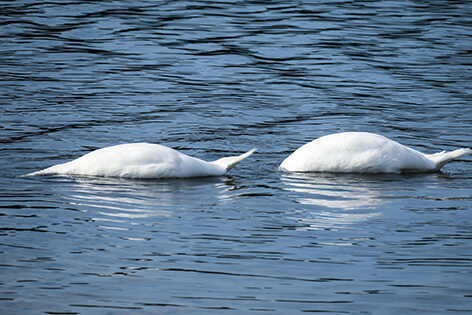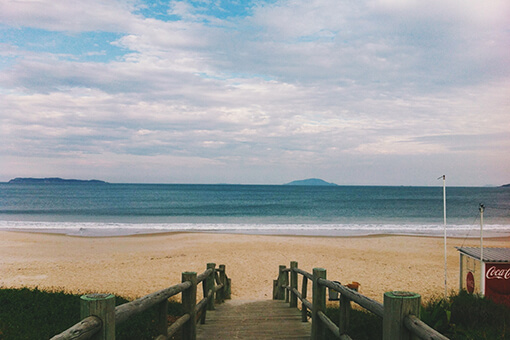Hi! It’s konkaz (@konkazuk) here.
With this article, we’re going to make a check on “Participle Clause”.

Having vague areas in your grammatical knowledge won’t help you speak English confidently. And, for many of us, this “participle clause” could be one of these areas, I presume…
Essential things about “participle clause” such as its structure, how to translate them into Japanese and how the sentences are to be created are explained in this article.
So, please have a look and let the knowledge reduce the area of vagueness for more confidence in speaking.
What is “Participle clause” in the first place?

“Bunshi-koubun” in English is called “Participle clause”.
“Participle clause” is basically…
The clause that plays a roll of both verb and conjunction.
For those who don’t know what the “participle” is, it has got a couple of forms…
The one is called
“present participle” whose verb form ends in “-ing”
and the other one is called
“past participle” whose verb form ends in “-ed” (with several exceptions).
(For more details, please visit《Eigo-jiru vol.22》!)
Here is an example sentence of participle clause…
Hearing the rumbling sound of thunder, she hurried to get home.
The part written in bold is “participle clause” and its opening word “Hearing” is a “participle” (Precisely, “Present participle” as I mentioned earlier.)

Huh? I just realised that this sentence hasn’t got a subject, has it?

Yeah, you are right. By using a participle and kicking a subject out of its section, you can create a sentence that includes only one subject because participle clause (the section that has a participle) plays a roll of “adverb”.
The word “Hearing” in this context is equivalent of “kiku-to” in Japanese, and you can see that it includes the verb “kiku” and the conjunction “-to”.
Patterns of participle clause

While you are reading a story or something else and suddenly bump into a form of participle clause, I suppose some of you might get frozen.
The two important things you should do when you come across the form of participle clause can be…
- Think what sort of conjunction can be hiding in the sentence.
- Get used to the form of participle clause by reading a lot of example sentences.
Let’s see what sort of patterns “participle clause” has…
① Time

Walking on the riverside, she found a fragment of some animal’s bone.
In this case, the sentence has got a flow like… one thing is followed by the other thing naturally at the time.
Judging from the natural flow of its context, we can use a conjunction of time “As”.
So, the sentence can be rewritten like…
As she walked on the riverside, she found a fragment of some animal’s bone.
If one action/thing is naturally followed by the other action/thing, conjunctions of time are likely to be fitted in.
Another example of similar sort…
Spotting a herd of impala, the lion lowered its body and started crawling slowly.
You can easily imagine that it can start with a conjunction “As” from its context, just like…
“As the lion spotted a herd of impala, it lowered its body and started crawling slowly.
“When” or “While” are also to be used as examples for conjunction of time other than “As“.
② Two things happening at the same time

What is called “Attendant circumstance” is the situation where two things are happening simultaneously.

This is the most frequently used pattern!
The man was sleeping on the sofa snoring loudly.
As you can see, there are two things, which are “sleeping on the sofa” and “snoring loudly”, are happening at the same time.
The part written with bold letters is “participle clause” and we can translate it into Japanese with the nuance of “with snoring loudly”.
…And we can imagine that conjunction “and” is hidden here.
The man was sleeping on the sofa, and he was snoring loudly.
Let’s see another example.
She is brushing her teeth listening to a story with audiobook.
Again, you can see two things; “brushing her teeth” and “listening to a story with audiobook” are happening at the same time.
And just like the example sentence one before, we can apply a conjunction “and”…
She is brushing her teeth and (she) is listening to a story with audiobook.
Alternatively, we can apply “while” to rewrite the sentence.
She is brushing her teeth while she is listening to a story with audiobook.
③ Cause / reason

Taking off all my clothes in public, I got arrested by the police.
Considering what happened in the main clause as a result of what happened in the participle clause, it’s imaginable that their relationship is “cause and result”.
So in this case, we can add a conjunction “Because” just like…
Because I took off all my clothes in public, I got arrested by the police.
Let’s see another example…
Breaking my leg, I had to go to hospital last night.
We can imagine that what happened in the participle clause has caused what happened next (the result), so again we can apply conjunction “Because” just like…
Because I broke my leg, I had to go to hospital last night.
Here, we can also use other conjunctions that indicate “reason”, such as “As 〜” or “Since 〜”.
④ Condition

Commuting with bicycle, you can actually save a good amount of money.
Comparing the participle clause with the main clause, you can see that the first half is giving some condition, so in this case we can use “if”, and it will be…
If you commute with bicycle, you can actually save a good amount of money.
Another example…
Buying this product, you can get the second one for free.
Again, with this example we can see that its participle clause is indicating “condition”, so we can rewrite the sentence with using “if”.
If you buy this product, you can get the second one for free.
⑤ Concession

Possibly, the participle clause that indicates “concession” is the least used one, but anyway…
Knowing it’s time to go to bed, I can’t stop watching YouTube channels.
Comparing the participle clause with the main clause, you can imagine that a hidden conjunction will be concessionary type, therefore…
Though I know it’s time to go to bed, I can’t stop watching YouTube channels.
Conjunction “though” can be used to rewrite the sentence.
Another example…
Doing as I have been told, I don’t seem to be improving at all.
You can see from its context that a concessionary conjunction is hidden, therefore it will be…
Although I am doing as I have been told, I don’t seem to be improving at all.
*There is no difference between “though” and “although” in terms of their meanings, but “although” sounds slightly more formal.
Participle clause (with past participle)

So far, we have looked through the examples with present participle, however “past participle” is also applied to participle clause as much.
The way to deal with it is the same as how we have dealt with present participle, so let’s have a look at examples in the same order.
① Time

Seen from the sky, they looked as small as ants.
With Japanese translation, it probably doesn’t sound like “passive form”, but the subject of the participle clause will be the same as the one in the main clause “they”, therefore if we apply a conjunction “when”,
and it will be…
When they were seen from the sky, they looked as small as ants.
② Two things happening at the same time

She slowly closed her eyes, thrilled by what will be waiting for her.
We can apply a conjunction “and” and it will be rewritten like…
She slowly closed her eyes, and she was thrilled by what will be waiting for her.
③ Cause / reason

Chosen as a manager, he felt more responsibilities.
From its context, you can see that the participle clause indicates the “reason” for the main clause. Hence, we can apply a conjunction “Because”, and it will be…
Because he was chosen as a manager, he felt more responsibilities.
④ Condition

Proved to be innocent, you will be released.
I think this one is easy to guess… We can use a conjunction “if” that indicates “condition”, and it will be…
If you are proved to be innocent, you will be released.
⑤ Concession

Discharged from hospital today, I didn’t feel that I was fully recovered.
With Japanese translation, it will sound like as if the person discharged himself/herself from hospital, but it’s hospital that gives permission for its patient to leave, so it should be treated as “passive form”.
Here we can use a conjunction “though” that indicates “concession” and it will be…
Though I was discharged from hospital today, I didn’t feel that I was fully recovered.
How to write “participle clause”

Let’s see how we can write the “participle clause”.
What we are going to do is basically the contrary procedure of what we have done in the last chapter.
What we need to keep in mind before transforming an ordinary clause into a participle clause is that…
The clauses (a participle clause and a main clause) that are divided by a comma should have the same subject.
We better check this first, and secondary, the sentence we can apply the form of “participle clause” should have a “conjunction”.
Present participle

Right.
Let’s pick the first example sentence from the last chapter…
As she walked on the riverside, she found a fragment of some animal’s bone.
The subject “she” who walked on the riverside and who found a fragment of some animal’s bone are identical, aren’t they?
And we can recognise that the clause before a comma has got a form of
conjunction + subject + verb
① First, we remove “conjunction + subject” from the sentence…
As she walked on the riverside, she found a fragment of some animal’s bone.
👉 Walked on the riverside, she found a fragment of some animal’s bone.
② Subsequently, transform the verb form at the beginning of the sentence into the form of present participle ; “-ing”.
Walked on the riverside, she found a fragment of some animal’s bone.
👉 Walking on the riverside, she found a fragment of some animal’s bone.
Here we go, the form of participle clause has been completed!

It’s quite easy once you get used to doing it.
Past participle (passive form)

The procedure to create a participle clause with using passive form is no different from how we did with present participle.
Because he was chosen as a manager, he felt more responsibilities.
After we have checked the subjects in both clause before and after a comma are identical, we remove “conjunction + subject” from the sentence…
Because he was chosen as a manager, he felt more responsibilities.
👉 Was chosen as a manager, he felt more responsibilities.
And then we transform the verb form at the beginning of the sentence into the form of present participle : “-ing”…
Was chosen as a manager, he felt more responsibilities.
👉 Being chosen as a manager, he felt more responsibilities.
However, present participle is usually omitted from the participle clause with passive form, so it will be completed as…
👉 Chosen as a manager, he felt more responsibilities.
*However, as an exception, present participle “being” can be kept as it is in the participle clause as long as it indicates “cause/reason”.
(So, that means we can also keep “Being” in the sentence with the example above.)
Summary

We have looked through the basic knowledge of participle clause.
In general, participle clause is rarely used in our daily conversations apart from the form of “attendant circumstances” (②)
Therefore, you don’t need to work on it hard enough to be able to use it, however you better know about its basics so that you can comprehend sentences just fine.
Finally, here is today’s summary…
- Participle clause is a clause that plays a roll of both verb and conjunction.
- Think what sort of conjunction is hidden in the sentence from its context.
- Check if the clause is to be translated with an active form (present participle) or with a passive form (past participle).
- Check if the clauses that are divided by a comma have the same subject before you work to create a participle clause.
Well, I hope you have found the information given here useful.
Bye now.
konkaz

